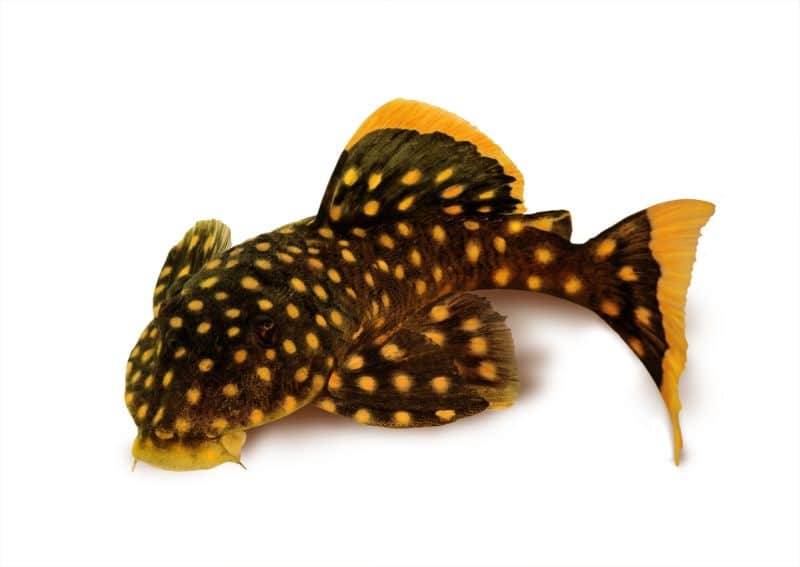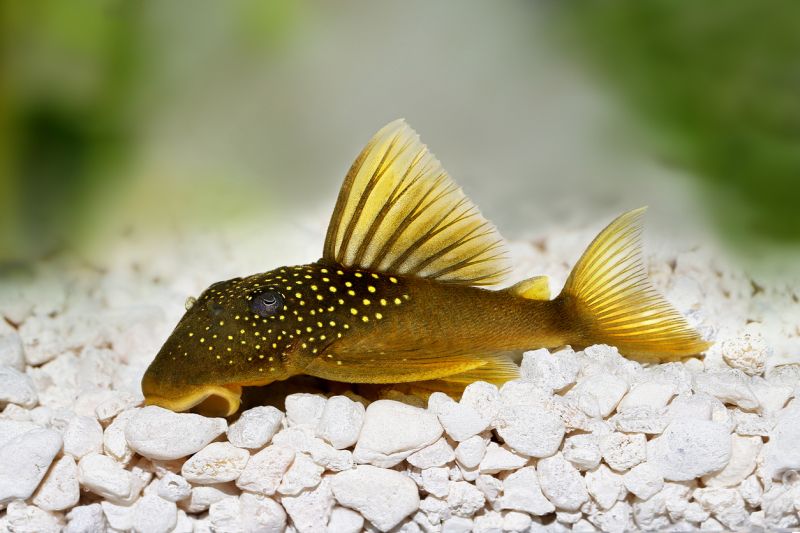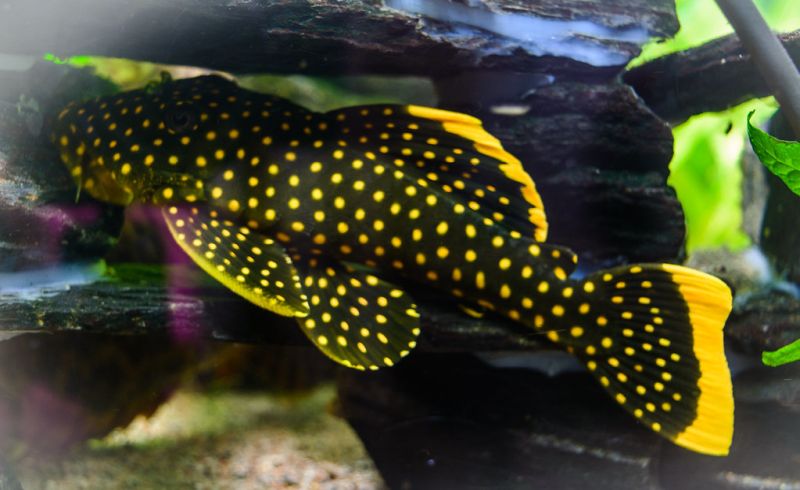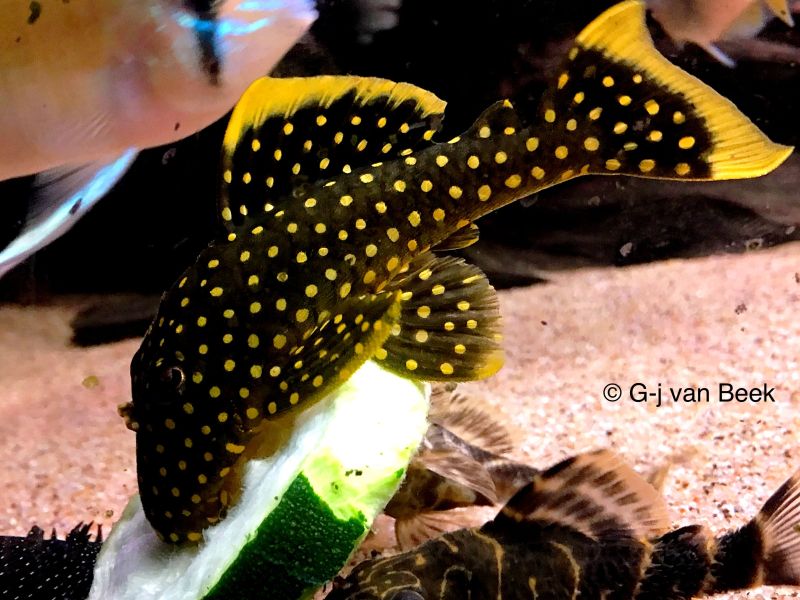Gold nugget plecos are a delightful departure from what other plecos typically look like. Normally when we think of a pleco the image that comes to mind is of a drab and unexciting fish.

Dull browns and blacks are indeed very common in this family of freshwater fish. But there are also notable exceptions like the gold nugget pleco! With its brilliant yellow spots and stripes, there are few bottom-dwelling fish that can compete with it in terms of beauty. But does being beautiful mean that gold nugget pleco care is beyond the average aquarist?
What are Gold Nugget Plecos?
Classifying plecostomus species is something that ichthyologists (scientists who study fish) are still sorting out. The issue is that there are hundreds of species, many of which are extremely closely related. Figuring out which are just color morphs, which are subspecies, and which are truly separate is difficult even for them!
The gold nugget pleco was originally described using the L-number classification system in 1981. You will still sometimes see it described as L018 or L-18, being the 18th species in line to be formally classified.
With its fan-like dorsal fin and shining spots, it is easy to see how gold nugget plecos get their name! And as one of the most gorgeous freshwater fish, they tend to be pricier than nearly any pleco out there save the exotic Zebra Plecos (L046).
As a member of the Baryancistrus group, it is closely related to bristlenose plecos and other plecos of the Ancistrus genus! These fish are all medium-sized compared to other plecos, rarely growing larger than 10 inches. They also love eating wood, something we will go into greater detail about below!
Like other species of plecostomus the gold nugget pleco baryancistrus is from South America. Specifically, the tropical region of the Amazon River tributaries in Brazil! This gives us an excellent idea of the sort of water quality and water temperature they need.
- Scientific Name: Baryancistrus sp. (usually Baryancistrus xanthellus)
- Origin: Amazon River tributaries
- Length: 7 to 10 inches
- Aquarium Size: 40+ gallons
- Temperament: Peaceful; Territorial
- Ease of Care: Easy
Gold Nugget Pleco Care

While there are a few quirks to understand, gold nugget pleco care is not too difficult even for new aquarists. And by following what we’ve outlined here you are sure to enjoy a healthy fish for years to come!
Aquarium Size for the Gold Nugget Pleco
The gold nugget pleco is a good-sized fish; not as large as some other freshwater fish but still sizeable. So for a single adult, we are looking at an aquarium around 40 gallons in tank size when fully grown.
You don’t need a massive tank but you do want an aquarium environment that won’t feel too cramped for a 10-inch catfish. But if you can provide a larger tank it certainly helps since these fish eat and poop quite a lot!
And if you are keeping gold nugget pleco baryancistrus with other tank mates then you will need more space still. Unfortunately, this plecostomus species can be very territorial towards other fish when it comes to securing a good hiding place.
Gold nugget plecos can’t bite but they will show their large pectoral fins in threat displays and shove other fish away if they feel like their space is being intruded on. Otherwise, they are very good at minding their own business, especially with a spacious tank size.
Since gold nugget plecos are not especially active you don’t need too much additional swimming space. In fact, loads of hiding places, plants, and driftwood are exactly what these shy fish prefer!
Bright tanks tend to stress them out since your gold nugget pleco will feel continually exposed and vulnerable. In their natural habitat the water tends to be dimly lit and stained brown with plant tannins.
Gold Nugget Pleco Size
Gold nugget plecos are medium-sized and not a very large fish. Fully grown golden nugget plecos have an adult size of 7 to 10 inches, which is larger than most community aquarium fish but not especially giant.
Water Parameters for Gold Nugget Plecos
Like most Amazonian fish from South America, the gold nugget pleco is a lover of tropical conditions. These fish are found very close to the equator where temperatures rarely change much over the seasons.
This means that we want to aim for conditions that are very warm; temperatures of 74-82° F are natural for them. Any colder and you will likely see signs of stress in your gold nugget pleco in the form of a lack of appetite. Cold water weakens their immune systems as well, allowing opportunistic diseases like ich and fin rot to take hold.
Also, gold nugget plecos live in water that is usually soft (low dissolved minerals) and acidic (low pH) in terms of water parameters. Since tap water in most countries has a hard, alkaline profile, you may need to counteract these minerals with additives.
Many pet stores have plant tannins bottled that will help shift the water parameters towards neutrality or acidity. You can also add Indian almond leaves and driftwood, both of which would normally release tannic acids in their natural habitat!
It is more important to match water parameters with wild-caught fish like gold nugget plecos because they have only recently entered the aquarium trade.
Many captive-bred fish are not so picky, such as common plecostomus. But gold nugget plecos are a little more sensitive and need to be treated appropriately.
Gold Nugget Plecos and Nitrogenous Waste
You will want not only a large aquarium but also a high-quality filter when keeping gold nugget plecos. This is because these wild-caught fish can be fairly sensitive to high levels of nitrogenous waste products.
These pollutants are ammonia, nitrite, and nitrate, all of which form from the waste products released by your aquarium pets. The beneficial nitrifying bacteria in the system will convert ammonia into nitrite and then again into nitrate.
Most captive-bred plecos are extremely hardy because their ancestors were tank-bred generations ago and adapted to both hard water and higher ammonia levels.
But each gold nugget pleco is a new addition to the hobby and is quite sensitive to pollutant levels. So we want to avoid any detectable levels of ammonia since these fish never have to be exposed to even trace levels in the wild.
This means keeping them in an undercrowded, large aquarium where pollutants have plenty of space to remain unconcentrated until processed by the filter. And keeping up with regular filter maintenance and water changes periodically!
Aquascaping for Gold Nugget Plecostomus

In the aquarium hobby, we often set up our tanks first and add fish as an afterthought. But you want to be a little more thoughtful when setting up a fish tank for gold nugget plecos.
For starters, they can sometimes be very rough on aquatic plants as they grow older. It is not the fault of the gold nugget pleco and they aren’t usually trying to eat your aquatic plants. They simply want to eat algae.
But as they get large they will chew rather aggressively on leaves. As they chew they can often cause damage that fails to heal well since in an aquarium the gold nugget pleco will keep coming back again and again to eat algae.
Tougher plants like Java Fern and Anubias are the safest choices. your gold nugget pleco aquarium. And if you prefer plants that root along the bottom, try Eelgrass (Vallisneria sp.). They are durable, fast-growing, and will withstand any chewing that your pleco can dish out!
Substrate Choices for the Gold Nugget Pleco
Overall, it is not too important whether you offer your gold nugget pleco a hard or soft substrate. A gravel substrate is not too big of an issue because the fish will spend a lot of its time attached to rocks, aquarium glass, and driftwood, like other suckermouth catfish.
Many aquarists think that a sandy substrate is required for any scaleless fish. But plecostomus species are quite tough and don’t need to be babied in this way. Though if you are looking to create an aquarium as close to its natural environment as possible then by all means, use a sandy substrate!
Gold Nugget Plecostomus Tank Mates
Choosing tank mates for gold nugget plecos is not especially difficult. They are mostly peaceful and will ignore the majority of fish in the aquarium community. Even very small fish like tetras and guppies are in no danger of being eaten or bothered since gold nuggets are mostly vegetarian.
Occasionally you may find your gold nugget pleco trying to attach itself to large, slow-moving fish like discus. Unfortunately, many plecos like to rasp mucus from the sides of slow-moving, peaceful fish. It’s not super common, especially if your gold nuggets are well fed.
But if you see it, take it as a sign that you need to offer more food. And in the worst-case scenario, you may need to move some fish in the aquarium community to a new home.
The only real problems you’re likely to run into are keeping gold nuggets with other bottom dwellers. Many other catfish like to compete for the same hiding places, which can drive fights over territory.
Other species that live along the bottom like loaches, cichlid, and eels can also get into fights sometimes. But in a spacious tank with plenty of hiding places, these should be minimal and swift. It’s always best to stick with tank mates that won’t compete with your golden nugget pleco for space along the bottom!
Gold Nugget Pleco Diet

Feeding gold nugget plecos is not too difficult once you are familiar with their core dietary needs! In their natural habitat, these freshwater fish graze along hard surfaces to consume algae and microbial biofilms. They also slurp up small worms and other animals living within this film.
A balanced and varied diet includes a mixture of plant and animal-based food. Stick to mostly vegetarian items like balanced vegetables (spinach, peas, lettuce, and zucchini). You can clip these in place with a veggie clip so they don’t go floating around the tank.
If your gold nugget pleco is more nocturnal and too shy to eat during the day then place the vegetable clip near the bottom shortly before the lights go out.
However, these fish do eat small amounts of animal protein as well. This means that a well-rounded diet should include offerings of brine shrimp, bloodworms, and other invertebrate-based food!
And as I mentioned earlier, it is also important to keep driftwood in any gold nugget pleco aquarium. Waterlogged driftwood provides valuable roughage and nutrients lacking in any other food you can offer. Driftwood also acts as a secondary food source in times of scarcity.
While they eat mostly algae gold nugget plecos will also sometimes eat living plants if they have very soft leaves. Plants like Cabomba and Anacharis may become a salad buffet for your pleco species, especially if they aren’t getting enough greens from algae and other sources.
Sinking pellets made of pressed algae like spirulina wafers can also help supplement fresh greens in tehir diet!
Keep in mind that they can be picky eaters for the first few weeks. Especially if they have only recently arrived to your local pet store. This is because all gold nugget plecos are wild-caught fish.
They have to endure a lot of stress when they are shipped from Amazon river tributaries to distributors and warehouses to your pet store and finally your home. They will likely need to to adjust to the continual changes of each new tank.
Breeding Gold Nugget Plecos
Unfortunately, gold nugget pleco breeding is mostly a mystery since they have not been bred in captivity to anyone’s knowledge. Every fish you will see in pet stores is a wild-caught specimen.
If you manage to breed gold nuggets then you are going to find yourself in huge demand because captive-raised babies are practically unheard of in today’s aquarium hobby!
That said, we can guess quite a lot about their breeding habits because most plecos spawn in a very similar fashion. The vast majority are cavity spawners that breed seasonally.
When the waters rise during the rainy season, the rivers flood, and new habitats emerge along the shore. Male plecos fight for cavities that they, flaring their dorsal and caudal fins in impressive displays that ward off rivals and impress watching females.
Once they coax a willing female within, other plecos will then spawn there, where one or both parents stand watch over the eggs until they hatch.
The young plecostomus then feed on all the algae in the surrounding area, moving out further and further from their nest until they continue life on their own as solitary fish.
Captive-bred rare fish are always desirable because they are hardier than their wild-caught parents. With enough generations, they become more flexible in terms of water quality, feed more reliably, and become easier to breed.
That said, golden nugget plecos are even more challenging because they aren’t very sexually dimorphic; meaning it’s difficult to sex them visually. Many of the other species of pleco in the baryancistrus/ancistrus group have cheek spines that are elongated in males.
Males will use these cheek spines to fight off one another and ward off predators.
It has yet to be determined whether a male gold nugget pleco has elongated cheek spines or not. But this may be a clue to decoding the mystery of these unique freshwater fish!
More Frequently Asked Questions about Gold Nugget Plecos
The final gold nugget pleco size is between 7 and 10 inches long. This makes them medium-sized compared to other loricariid catfish like common plecos and dwarf otocinclus!
While they don’t cost thousands of dollars like an arowana or flowerhorn cichlid, a gold nugget pleco is a fairly expensive fish! A new import that is around 2 to 3 inches long will likely cost you between $50 and $80!
Yes, gold nugget plecos do eat algae and quite a lot of it! Just keep in mind that they are large fish and few aquariums are capable of growing enough algae to feed a single gold nugget pleco forever. You will need to supplement their diet with other greens like blanched vegetables and sinking pellet prepared foods!
Gold nugget plecos aren’t especially aggressive; in fact, they can be kept with tank mates of nearly any size or type. However, they are territorial and will defend their favorite hiding spots from intruders.
If you do have several plecos in the same tank then going with a larger tank size as they grow up will ensure that everyone has space as they approach their final adult size.

